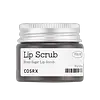What's inside
What's inside
 Key Ingredients
Key Ingredients

No key ingredients
 Benefits
Benefits

 Concerns
Concerns

 Ingredients Side-by-side
Ingredients Side-by-side

Sucrose
HumectantPolyisobutene
Citrus Limon Seed Oil
MaskingPrunus Amygdalus Dulcis Oil
Skin ConditioningTriethylhexanoin
MaskingHydroxystearic Acid
CleansingCocos Nucifera Oil
MaskingTocopheryl Acetate
AntioxidantCitrus Limon Peel Powder
AbsorbentDaucus Carota Sativa Seed Oil
EmollientCanola Oil
EmollientHelianthus Annuus Seed Oil
EmollientCaprylyl Glycol
EmollientGlycerin
HumectantCaprylhydroxamic Acid
Beta-Carotene
Skin ConditioningDaucus Carota Sativa Root Extract
Skin ConditioningParfum
MaskingLimonene
PerfumingLinalool
PerfumingCitronellol
PerfumingGeraniol
PerfumingSucrose, Polyisobutene, Citrus Limon Seed Oil, Prunus Amygdalus Dulcis Oil, Triethylhexanoin, Hydroxystearic Acid, Cocos Nucifera Oil, Tocopheryl Acetate, Citrus Limon Peel Powder, Daucus Carota Sativa Seed Oil, Canola Oil, Helianthus Annuus Seed Oil, Caprylyl Glycol, Glycerin, Caprylhydroxamic Acid, Beta-Carotene, Daucus Carota Sativa Root Extract, Parfum, Limonene, Linalool, Citronellol, Geraniol
Sucrose
HumectantCaprylic/Capric Triglyceride
MaskingGlycerin
HumectantEuphorbia Cerifera Wax
Sorbeth-30 Tetraoleate
EmulsifyingButyrospermum Parkii Butter
Skin ConditioningBis-Diglyceryl Polyacyladipate-2
EmollientWater
Skin ConditioningStearalkonium Hectorite
Gel Forming1,2-Hexanediol
Skin ConditioningPropylene Carbonate
SolventTheobroma Cacao Extract
Skin ConditioningEthylhexylglycerin
Skin ConditioningButylene Glycol
HumectantSaccharum Officinarum Extract
MoisturisingDextrin
AbsorbentCitrus Limon Fruit Extract
MaskingHoney
HumectantSucrose, Caprylic/Capric Triglyceride, Glycerin, Euphorbia Cerifera Wax, Sorbeth-30 Tetraoleate, Butyrospermum Parkii Butter, Bis-Diglyceryl Polyacyladipate-2, Water, Stearalkonium Hectorite, 1,2-Hexanediol, Propylene Carbonate, Theobroma Cacao Extract, Ethylhexylglycerin, Butylene Glycol, Saccharum Officinarum Extract, Dextrin, Citrus Limon Fruit Extract, Honey
 Reviews
Reviews

Alternatives
Ingredients Explained
These ingredients are found in both products.
Ingredients higher up in an ingredient list are typically present in a larger amount.
Glycerin is already naturally found in your skin. It helps moisturize and protect your skin.
A study from 2016 found glycerin to be more effective as a humectant than AHAs and hyaluronic acid.
As a humectant, it helps the skin stay hydrated by pulling moisture to your skin. The low molecular weight of glycerin allows it to pull moisture into the deeper layers of your skin.
Hydrated skin improves your skin barrier; Your skin barrier helps protect against irritants and bacteria.
Glycerin has also been found to have antimicrobial and antiviral properties. Due to these properties, glycerin is often used in wound and burn treatments.
In cosmetics, glycerin is usually derived from plants such as soybean or palm. However, it can also be sourced from animals, such as tallow or animal fat.
This ingredient is organic, colorless, odorless, and non-toxic.
Glycerin is the name for this ingredient in American English. British English uses Glycerol/Glycerine.
Learn more about GlycerinSucrose is a natural sugar found in fruits, vegetables, and nuts. It is the main constituent of white sugar.
In skincare, sucrose is a humectant and can be a mild exfoliant.
Sucrose is hydrophilic, meaning it attracts water. This makes it an effective humectant and helps hydrate the skin.
Studies show sugars may worsen acne-prone skin due to it disrupting the skin's natural biome. We recommend speaking with a professional if you have any concerns.
In some products such as body scrubs, sucrose is used as an gentle exfoliant.
The term 'sucrose' comes from the french word for sugar, 'sucre'.
Learn more about Sucrose